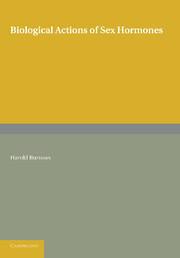Book contents
- Frontmatter
- CONTENTS
- PREFACE
- PART I GONADOTROPHINS
- PART II GONADAL HORMONES
- PART III ANDROGENS
- PART IV OESTROGENS
- CHAPTER XI Oestrogens
- CHAPTER XII The Action of Oestrogen on the Embryonic Gonads. and Miillerian and Wolffian Systems
- CHAPTER XIII The Action of Oestrogen on the Anterior Lobe of the Pituitary, and on the Gonads after their Differentiation
- CHAPTER XIV The Action of Oestrogen on the Accessory Genital Organs after their Differentiation, with a special reference to inguinal hernia
- CHAPTER XV The Action of Oestrogen on the Accessory Genital Organs
- CHAPTER XVI The Action of Oestrogen on the Accessory Genital Organs
- CHAPTER XVII The Effects of Oestrogen on the Mamma
- CHAPTER XVIII Factors in the Causation of Mammary Cancer
- CHAPTER XIX The Effects of Oestrogen on Connective Tissues and Skin
- CHAPTER XX The Actions of Oestrogen on organs other than those considered in earlier chapters
- PART V PROGESTINS
- PART VI SEX HORMONES OF THE ADRENAL CORTEX
- APPENDIX
- REFERENCES
- GLOSSARY
- INDEX
CHAPTER XX - The Actions of Oestrogen on organs other than those considered in earlier chapters
from PART IV - OESTROGENS
Published online by Cambridge University Press: 05 June 2016
- Frontmatter
- CONTENTS
- PREFACE
- PART I GONADOTROPHINS
- PART II GONADAL HORMONES
- PART III ANDROGENS
- PART IV OESTROGENS
- CHAPTER XI Oestrogens
- CHAPTER XII The Action of Oestrogen on the Embryonic Gonads. and Miillerian and Wolffian Systems
- CHAPTER XIII The Action of Oestrogen on the Anterior Lobe of the Pituitary, and on the Gonads after their Differentiation
- CHAPTER XIV The Action of Oestrogen on the Accessory Genital Organs after their Differentiation, with a special reference to inguinal hernia
- CHAPTER XV The Action of Oestrogen on the Accessory Genital Organs
- CHAPTER XVI The Action of Oestrogen on the Accessory Genital Organs
- CHAPTER XVII The Effects of Oestrogen on the Mamma
- CHAPTER XVIII Factors in the Causation of Mammary Cancer
- CHAPTER XIX The Effects of Oestrogen on Connective Tissues and Skin
- CHAPTER XX The Actions of Oestrogen on organs other than those considered in earlier chapters
- PART V PROGESTINS
- PART VI SEX HORMONES OF THE ADRENAL CORTEX
- APPENDIX
- REFERENCES
- GLOSSARY
- INDEX
Summary
Liver. Pancreas. Blood and vascular system. Adrenals. Excretion of water and electrolytes. Thymus.
The Liver
(a) Weight. Korenchevsky and his colleagues (Korenchevsky & Dennison, 1934; Korenchevsky, Hall & Ross, 1939) reported a decrease in the weight of the castrated rat's liver under the influence of oestrogen; this result was less obvious in non-castrated rats. Selye (19406) noticed a reduction in the weight of the liver in rats which had been given oestradiol. Such an effect of oestrogen does not appear to be a pronounced or constant reaction. Griffiths, Marks & Young (1941) noted an increase in the weight of the liver in rats which had been treated with oestrogen.
(b) Histological changes in the bile ducts have been observed by Gardner, Allen & Smith (1941) in mice after the administration of oestrogen. The compounds used were oestradiol dipropionate or benzoate (16.6 to 50γ weekly), oestrone (250γ weekly) and stilboestrol (250γ weekly). This treatment caused the bile ducts to become thickened, rigid, white and somewhat nodular. The main duct was less affected towards the duodenal end. The cystic duct was thickened up to the neck of the gall-bladder. Microscopically the enlarged ducts showed an increase of the epithelial folds and of the glands, which sometimes reached as far as the serosa. The epithelium was hyperplastic and the ducts increased in extent.
Battaceano & Vasiliu (1936) say that when given to dogs oestrone causes at first a diminution in the volume of the liver which is followed by an increase. In a dog with a biliary fistula doses ranging from 1,000 to 5,000 r.u. arrested the flow of bile.
(c) Hepatoma and haemangioma. Miller & Pybus (1941) have noted a high incidence of hepatoma and haemangioma among mice of the- CBA strain after their continued subjection to oestrogen. These tumours appeared in 44.4 per cent of the normal males in a group of mice which had received subcutaneous injections of 300 i.u. of oestrone in olive oil once a week. In castrated males treated in the same way hepatomas appeared in 6.5 per cent, but none of these tumours developed in normal females under similar conditions. Gorer (1940) states that among his CBA mice which lived 11 months or longer hepatomata appeared in 18 of 35 males (51 per cent) and in 10 of 43 females (23 per cent).
- Type
- Chapter
- Information
- Biological Actions of Sex Hormones , pp. 377 - 388Publisher: Cambridge University PressPrint publication year: 2013

